The erudite Gaetano Atti narrates, in his Sunto storico della città di Cento (Historical summary of the city of Cento), that on July 6, 1796, two Napoleonic commissioners, named Ciney and Berthollet (to be identified, in all likelihood, with the painters Jacques-Pierre Tinet and Jean-Simon Berthélemy), arrived in the town with a mandate to raid the works that adorned the town’s churches. Having arrived at the temple of the Most Holy Rosary, the two allegedly had a painting by Guercino (Giovanni Francesco Barbieri; Cento, 1591 - Bologna, 1666), the Virgin of the Assumption, lowered into it, but they then decided to leave it in place because they “judged it to be a mess,” Atti laconically commented. According to the vulgate, still proudly handed down today by the inhabitants, the two commissioners would not have understood, through their ignorance, that the proportions of the Madonna painted by Guercino were out of scale since the work had been conceived for a view from below: thus the painting, seen up close and at eye level, presenting a squat Virgin, with her face backwards, nose up and chin prominently displayed, would not have met with the approval of the two Frenchmen and would have remained in its location. Guercino had painted it for the Church of the Rosary in 1620, as the inscription on the old frame attests (although there has long been debate about the canvas’ actual date of completion, which for some might date to a few years later), but it would not be until 1640 that it would be housed in the new building: a larger, more beautiful church designed to replace the old, late 16th-century church, no longer suited to the needs of an expanding community.
Guercino cared a lot about this church, and the same bond is the one that unites it to the inhabitants of Cento. Since 2012, however, they can no longer enter it: hard hit by the earthquake that, in May of that year, shook the provinces of Modena, Ferrara, Mantua and Rovigo, the church of the Rosary has not been usable since that year, nor is it still possible to imagine a date from which the people of Cento will be able to see it open and in activity again. In the meantime, however, action needed to be taken to ensure that at least the works preserved within it were not hidden from the view of citizens and outsiders alike: Cento is reflected in Guercino, the painter is the tutelary deity of this city, he is a shining beacon of the community, the inhabitants consider him a kind of secular and unofficial patron saint. Moved by this awareness of and love for their great artist, the people of Cento, after the Emilia earthquake, having settled the people and started and brought reconstruction to a good point, worked to finally welcome what had not been allowed to be seen since the first tremors: the works of Guercino that were in the buildings lashed by the earth’s movement. Seven years later, having found a suitable home, namely the eighteenth-century church of San Lorenzo, transformed into a Pinacoteca for the occasion, Giovanni Francesco Barbieri’s paintings are once again on view, and what was once in the city’s museums and churches now forms the itinerary of the exhibition Emozione barocca. Guercino in Cento, set up in the new “Pinacoteca San Lorenzo” and Rocca di Cento, and curated by Daniele Benati.
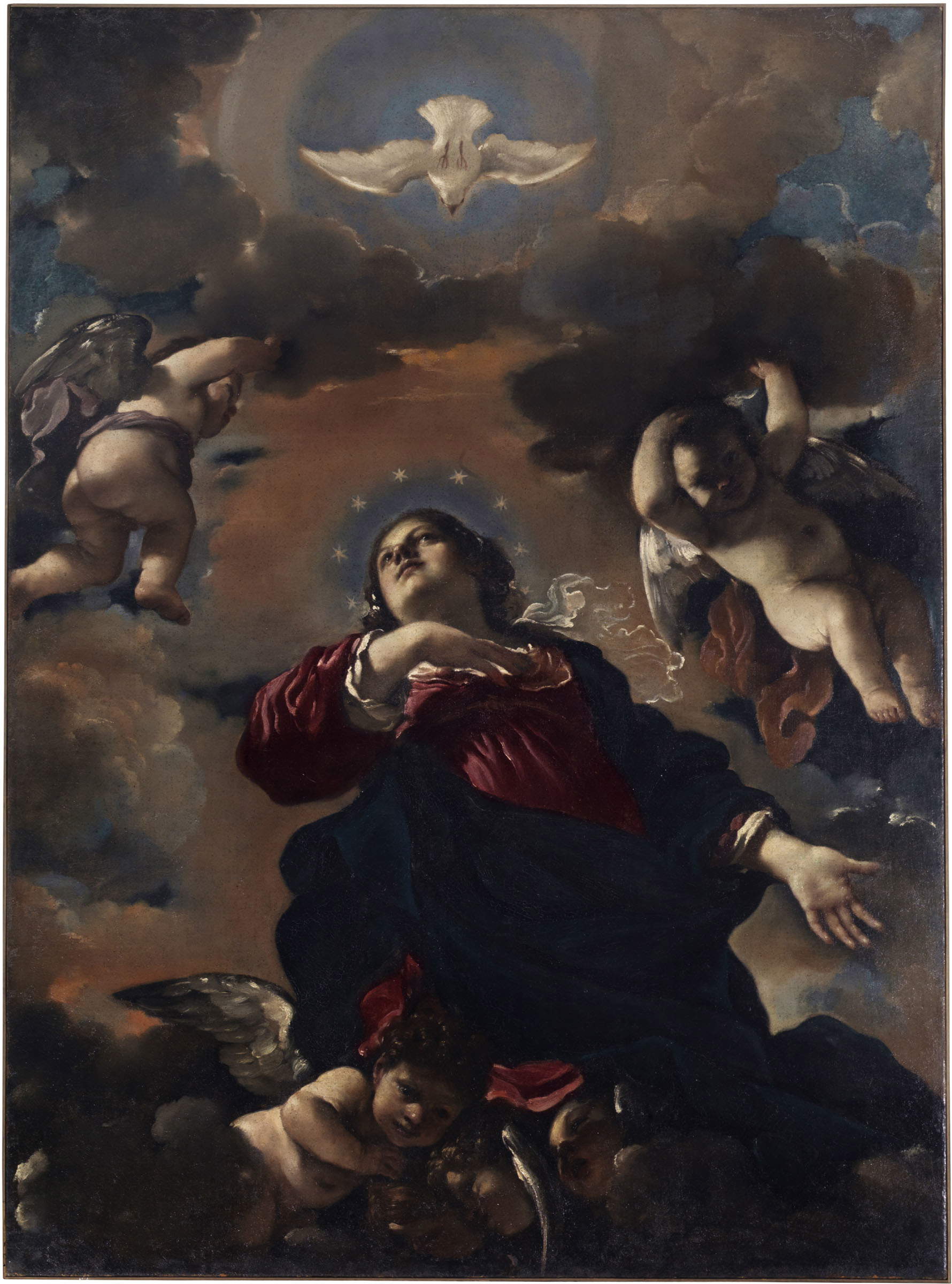 |
| Guercino, Virgin assumed (1620; oil on canvas, 224 �? 166 cm; Cento, Church of the Santissimo Rosario) |
 |
| Hall of the exhibition Baroque Emotion. Guercino in Cento |
Admittedly, not all of Guercino’s paintings kept in his hometown had been in storage in Bologna and Sassuolo for all this time: the Pinacoteca San Lorenzo was opened in 2016, and since then it had been able to house some of the works from the Pinacoteca Civica and churches in the area. And among them was theAssumption from the Rosario Church. Outside, however, were the other canvases that Guercino had painted for the church: the Crucifixion with the Madonna, St. Mary Magdalene and St. John the Evangelist, the Eternal Father, St. John the Baptist and St. Francis of Assisi, all executed for the new building, whose construction work he himself oversaw (he even designed its façade). Before the construction was finished, the artist had obtained for his family the juspatronage of the second chapel on the left side of the building: in return, he would finance the work and provide by his own hand to paint the works that would embellish it. Guercino kept his commitment and delivered the works even before the church was inaugurated: it was June 13, 1645, the mass that opened the new temple to worship was celebrated precisely in the “Barbieri chapel,” and we can assume that great was the astonishment of the people of Cento from the very beginning at seeing such a magnificent church that, several historians tell us, was called “the Gallery” by the inhabitants because of the splendor of the works in it. A centuries-old oral tradition, first set down in writing in 1760 by writer and art collector Francesco Algarotti (who said it had been reported to him by the church’s custodian), has it that, alongside the artist’s eponymous saints, John and Francis, the choice of the Eternal Father to complete the decoration of the intrados of the arch of the Barbieri chapel was due to the fact that God’s long beard alluded to the painter’s surname. A few years later, this bizarre self-celebration was to scandalize the writer Hester Lynch Piozzi, who in her Observations, an account dated 1786 of her Grand Tour of France, Italy and Germany, had words of blame for the artist, despite the fact that his genius had captivated her: “my partial preference of Guercino to anything and to every thing, shall not however bribe me to suppress my grief and indignation at his strange method of commemorating his own name over the altar where he was baptized, which shocks every Protestant traveler by its profaneness, while the Romanists admire his invention, and applaud his piety” (“my partial preference of Guercino over everything and everyone, does not induce me to repress my displeasure and indignation at that strange method of commemorating his name over the altar where he was baptized, which shocks every Protestant traveler by its profaneness, while the Catholics on the contrary admire his invention and praise his piety.”).
There is, of course, no reason to think that the artist really intended to crown the altar with an image of the Eternal Father for an admittedly rather trivial appeal to his surname. First, because he would have had no reason to: the stucco decoration of the chapel includes the coats of arms of Cento and the Barbieri family, placed at the base of the statues of Saints Paul the Hermit and Anthony the Abbot, eponyms of the artist’s brother, Paul Anthony, sculpted by the Bolognese Giovanni Tedeschi. Also, because this is not an isolated presence in Guercino’s art: in the same turn of the year, the Augustinian nuns of Bologna commissioned Giovanni Francesco Barbieri to paint an altarpiece for the high altar of their church (later demolished), having as its theme the Circumcision of Christ, which would have been surmounted by an image of the Eternal Father which, writes Jacopo Alessandro Calvi in his Notizie della vita e delle opere del cavaliere Gioan Francesco Barbieri, known as Guercino da Cento, a famous painter, “there was to be inserted in the upper ornament.” The first version of the work (this is, probably, the canvas now in the Galleria Sabauda in Turin) was discarded because it exceeded in size, while the second, which Calvi wants painted “in the course of the same night by torchlight,” was the right size and “filled the people with amazement, who saw how vivid and brilliant it was and knew how in such a short time it had been painted.” Today, the Augustinian’s Eternal Father, separate from the Circumcision (which, requisitioned by the Napoleons, is currently at the Musée des Beaux-Arts in Lyon), is at the Pinacoteca Nazionale in Bologna: and all three paintings in Cento, Turin and Bologna are the same, happy, lofty product of the hand that replicated the model, an old man with thick, long, disheveled hair parted by a scrim, and a wispy beard that falls across his chest, clad in the same broad cope, with different attitudes, however. The one in Turin spreads his arms outstretching his hands forward, hieratic, solemn, he is a God who communicates at once strength and protection, he is a supernatural apparition who is distant but welcoming, a presence at once distant and near. In contrast, the Bolognese Eternal Father, the one delivered to the Augustinian women, is a good-natured deity, leaning out of the clouds as if to check what is happening in that world on which his hand rests, peering at his creation with a distracted gaze, preceded by the dove of the Holy Spirit. The Eternal Father of Cento, on the contrary, of the three is the most human, the most like us, the most moving: we almost see him running, stretching out his arms toward his son hanging on the cross, his eyes lowered to reciprocate his suffering expression, almost more concerned with consoling him, embracing him, making him feel his closeness, than with receiving him in his glory.
It is well known, after all, that Guercino knew how to be a profoundly sentimental painter, his is an art that is capable of becoming theater to involve the viewer on an emotional level, to make him a participant in the scenes that, with skillful directorial mastery, Giovanni Francesco Barbieri paints to touch deep in the chords of the soul of those who observe his paintings: how can one remain impassive in front of that youthful masterpiece that is theMeeting between Christ and his mother, in those swollen and shiny eyes that are there to bathe in tears, in that sweet adolescent face furrowed by a motion of affliction and dismay, in the compassion of the Apollonian Christ who makes to hold his mother to himself, and in that marvelous, delicate hand that, trepidatiously, touches, laps, caresses for one last time the skin of his son? The same is true in the Barbieri Chapel, and here too the hands are the privileged medium with which Guercino expresses the pathos, the tension, the moods of the moment. Pater in manus tuas commendo spiritum meum: there is perhaps no more concrete evidence for the last words that St. Luke has Jesus utter in his Gospel, and which stand out in the rich gilded frame of the chapel now devoid of his works, moved temporarily to San Luca. God’s hands open to receive Christ’s spirit in a compassionate fatherly outburst. Those of St. John, joined in prayer, communicate his despondency mixed with melancholy and helplessness. Those of Mary become an obvious expression of the sorrow of the mother who sees her son torn apart, and of the discouragement that is not yet fully expressed with her eyes, but at the same time they make clear the fact that she has accepted Jesus’ fate. And there is also the silent sorrow of Magdalene, who uses her hands to wipe away her tears.
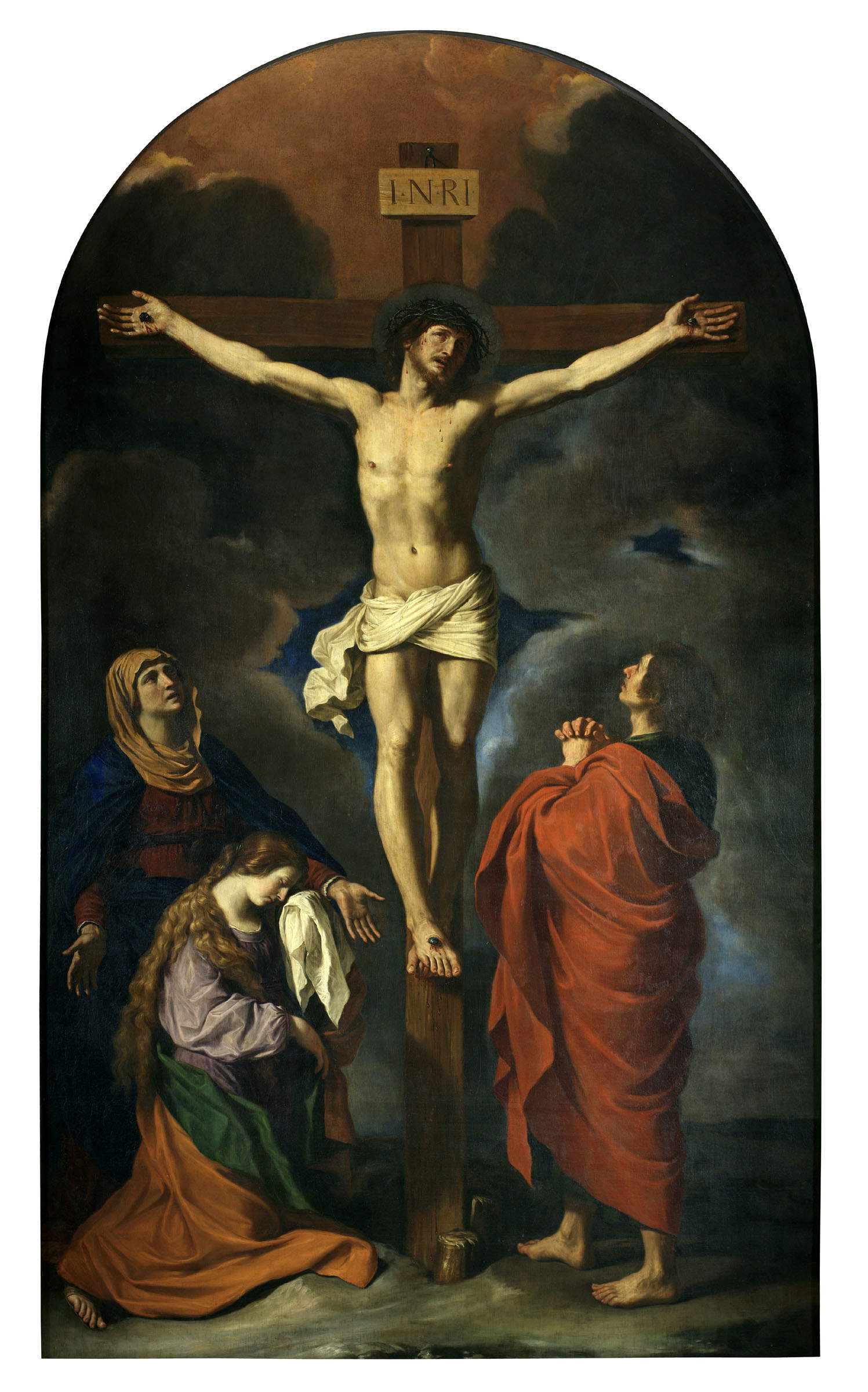 |
| Guercino, Crucifixion with the Madonna, Magdalene and St. John the Evangelist (1643-1645; oil on canvas, 383 x 216.5 cm; Cento, Church of the Most Holy Rosary) |
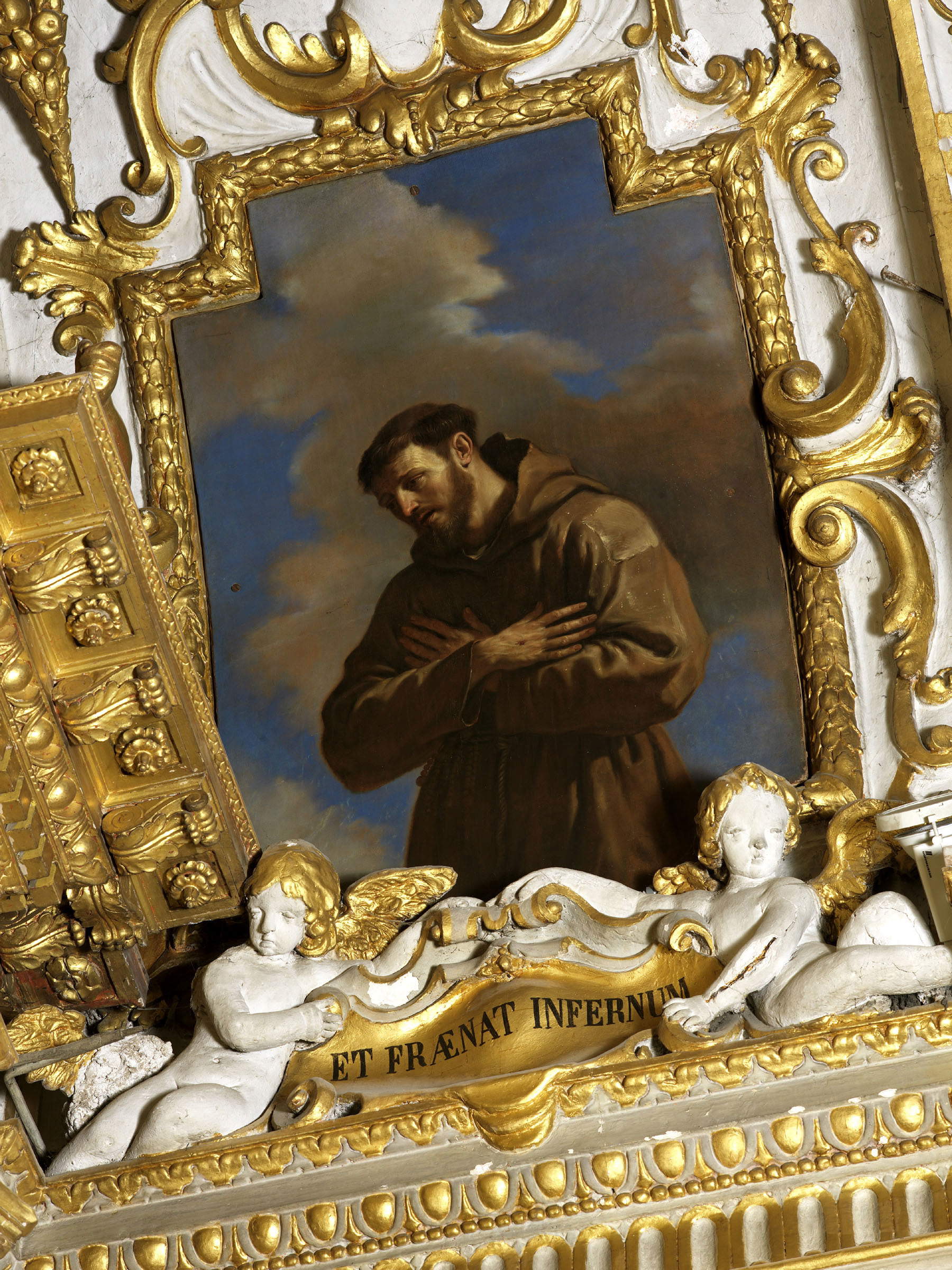 |
| Guercino, Saint Francis (1643-1645; oil on canvas, 147 x 99 cm; Cento, church of the Santissimo Rosario) |
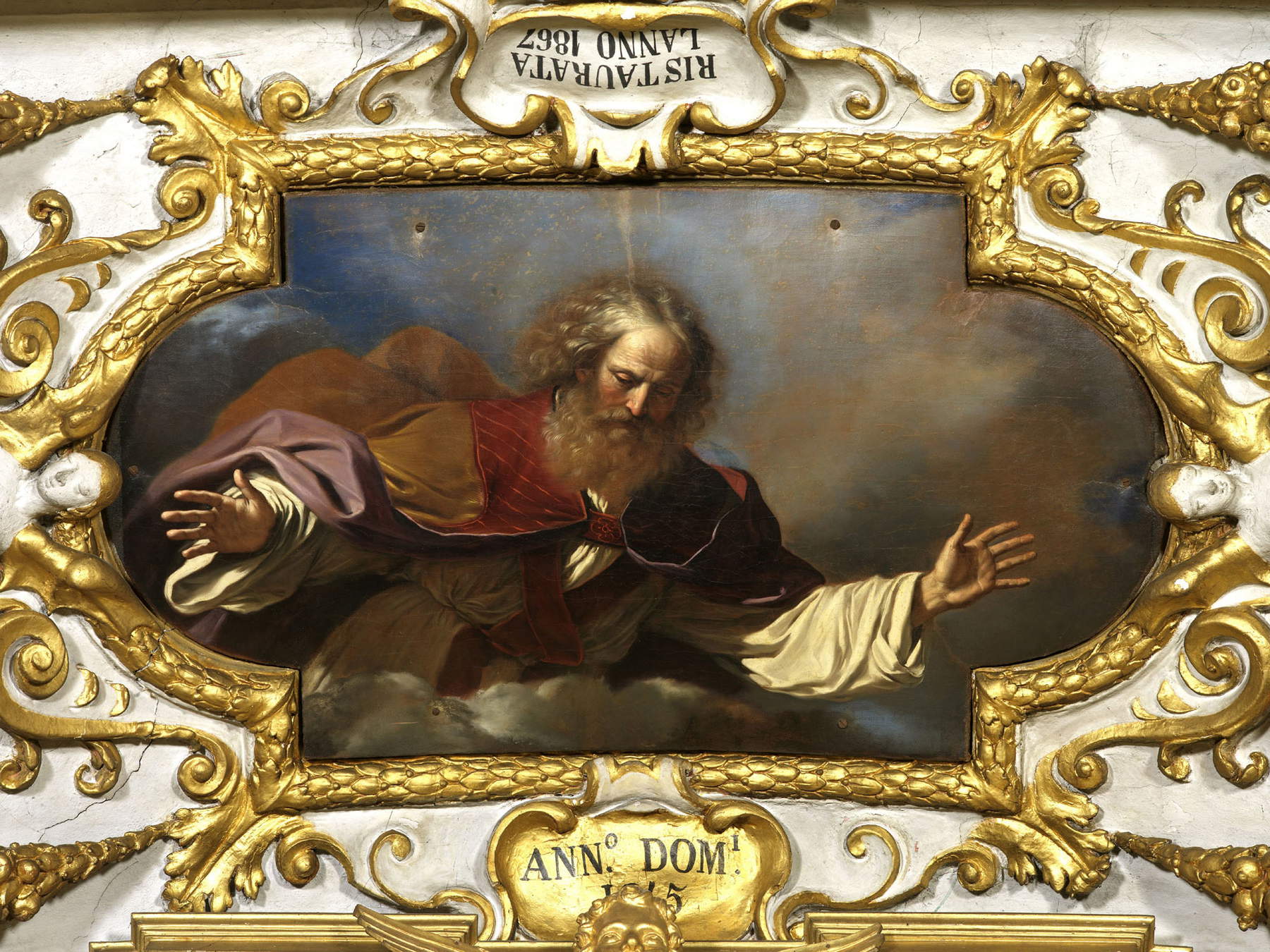 |
| Guercino, Padre Eterno (1643-1645; oil on canvas, 98 x 180 cm; Cento, church of the Santissimo Rosario) |
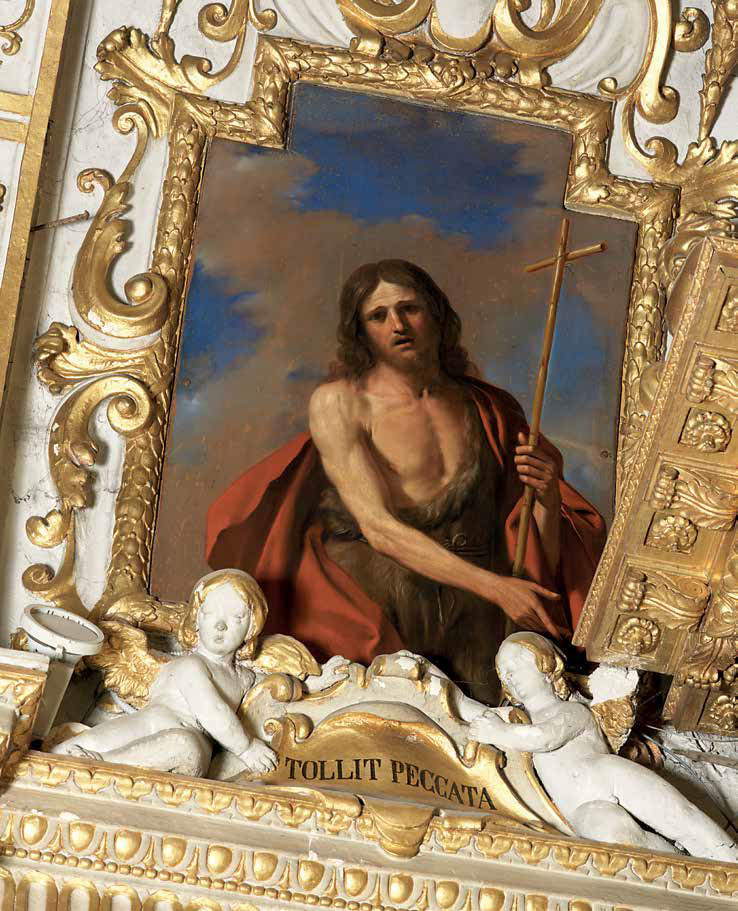 |
| Guercino, Saint John the Baptist (1643-1645; oil on canvas, 147 x 99 cm; Cento, church of the Santissimo Rosario) |
 |
| Guercino, Crucifixion, detail of Magdalene |
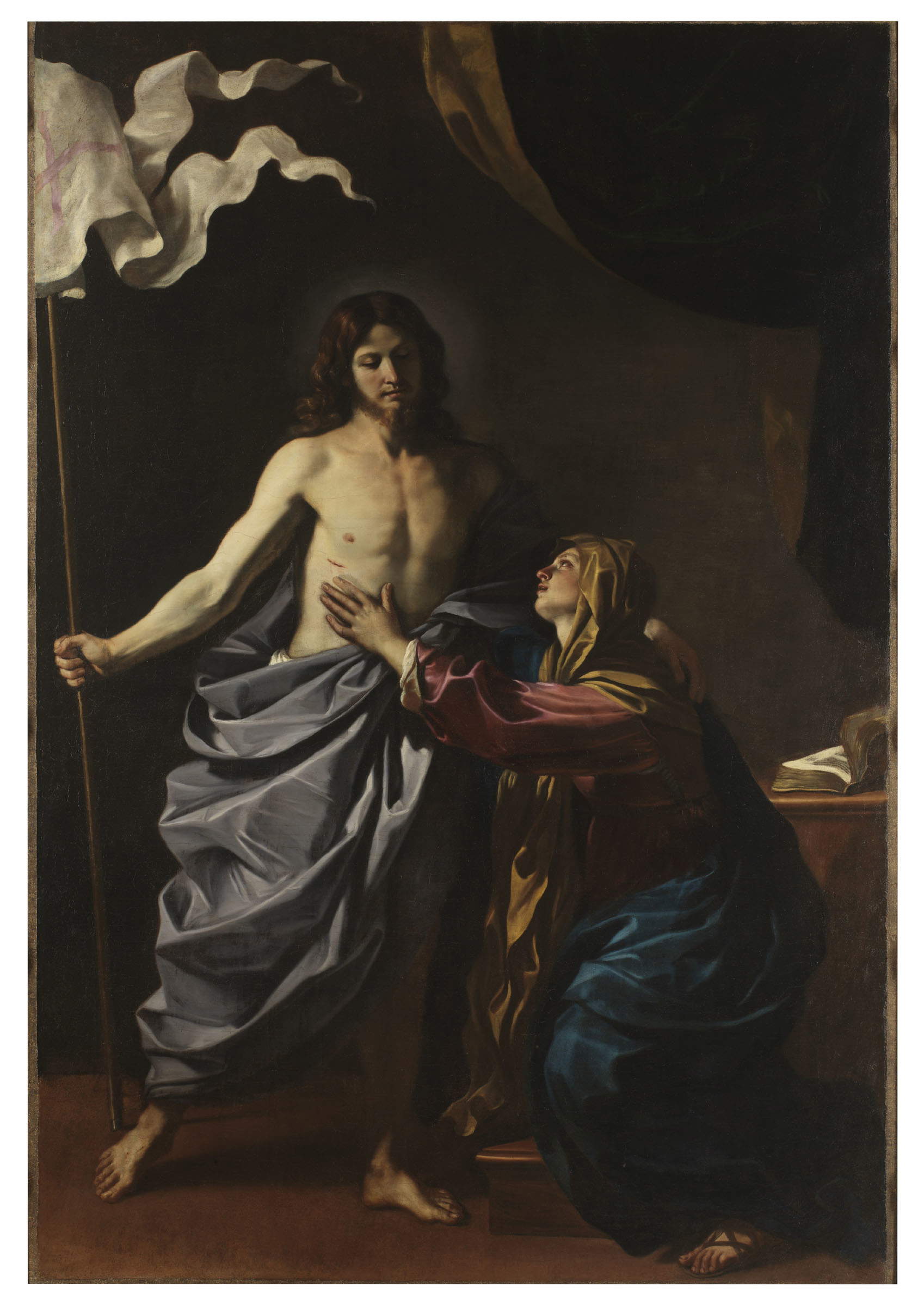 |
| Guercino, Risen Christ Appears to the Mother (1628-1630; oil on canvas, 260 �? 179.5 cm; Cento, Pinacoteca Civica) |
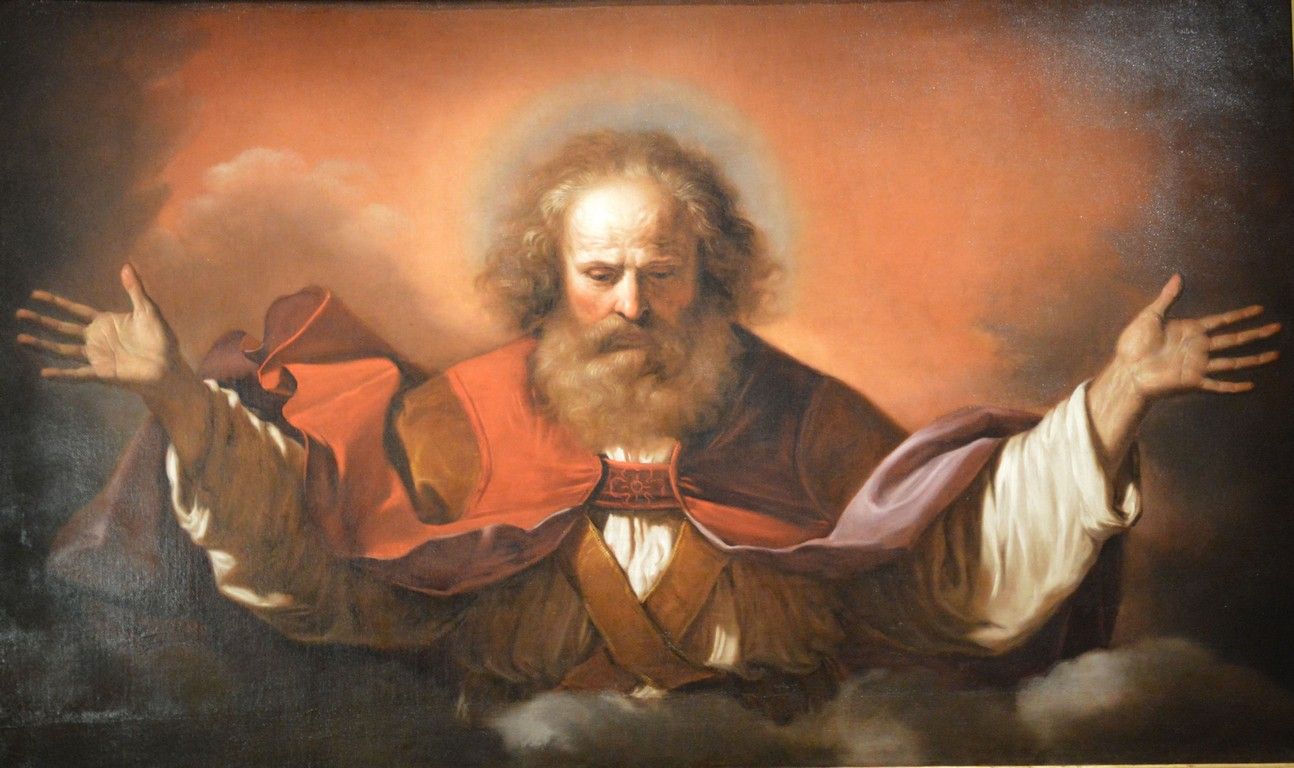 |
| Guercino, Eternal Father (1646; oil on canvas, 106 �? 176 cm; Turin, Galleria Sabauda) |
Everything is bathed in those warm neovenetian hues that, though toned down compared to certain vigorous youthful trials, still envelop the scene, accentuating its emotional valence. The Sapphic skies, almost always caught at the moment when evening gives way to night, are furrowed by ominous dark clouds, tinged here and there by the last reddish glows of sunset. The light, as is typical of many of Guercino’s works, gives rise to strong contrasts between illuminated and shaded areas and, in the canvas of the Eternal Father, leaps over hair and beard in bright highlights that suggest the idea of movement, made perhaps even more evident by the ray that illuminates the left sleeve of the tunic, while the purple cope is muted into somber violet hues by the shadow that envelops the deity’s humeri. The same effects radiate from Magdalene’s blond hair, which falls softly over the lilac sleeves of her robe and contrasts with her pearl-colored complexion, while the ultramarine of the Virgin’s mantle almost blends with the tones of the sky.
In describing this painting, Sir Denis Mahon, the great English scholar who rediscovered the Emilian painter and became his foremost expert, noted “a considerable difference in quality between the altarpiece and the three ceiling paintings” (so in the catalog of the major 1968 Bolognese exhibition he curated, the first monographic exhibition on Guercino, which marked the beginning of renewed interest in the painter), attributing this discrepancy to repainting carried out in 1760 by Benedetto Gennari (Cento, 1633 - Bologna, 1715), the artist’s nephew and pupil. It is true that the Crucifixion and the three figures in the arch are separated by significant differences, although subsequent critics have noted (including at the 2019-2020 exhibition) that the divergences cannot be attributed to deviations in quality, but if anything to the degree of freedom that animates the compositions: in other words, the artist, in the altarpiece, having to conceive a devout composition that was capable of conveying anguish and emotion to the faithful and that adhered to the Gospel narrative, could not achieve that freshness that, on the other hand, animates the saints and the Eternal Father and that the aforementioned Calvi already discerned in the canvas for the Bolognese Augustinian nuns (“I, who was able to see it up close, detected in it a supreme frankness and happiness of scornful and resolute brushwork”). Scholar Elena Bastelli suggests that Mahon “underestimated the value of the altarpiece” and did not take into account the fact that the restoration of the work, carried out in 1968, had removed Gennari’s repainting, restoring the altarpiece to optimal legibility conditions: the English art historian compared the Cento Crucifixion with the one painted 20 years earlier for Reggio Emilia, finding that the latter was “still all within the historical course of major seventeenth-century art,” as opposed to the later one which, in his view, “seems almost to flow back from Reni toward Cesi, toward a Counter-Reformation composure, such as we find in the Cesi Crucifixion at the Certosa in Bologna, from which Guercino also seems to take up certain cold, silvery, precious tones in the side saints.” The dependence on Rhenish models, on which almost all critics have emphasized, becomes less stringent at the moment when Guercino humanizes his Christ more, with the body that, despite its classical harmony of proportions (Mahon, in 1967, related it to a sheet preserved in the Ashmolean Museum in Oxford), falls heavier, with his face contracted in a grimace of pain that is more oppressive than that which gripped Guido Reni’s Christs, with the striae of blood that furrow his face and fall on his chest (a detail the master tended to downplay). And if punctual is the reference to the icy, brilliant painting of Bartolomeo Cesi (Bologna, 1556 - 1629), nevertheless it will be necessary to emphasize that Guercino’s emotional charge is unknown to the Bolognese, who holds it in a more composed, more measured, more mannered feeling.
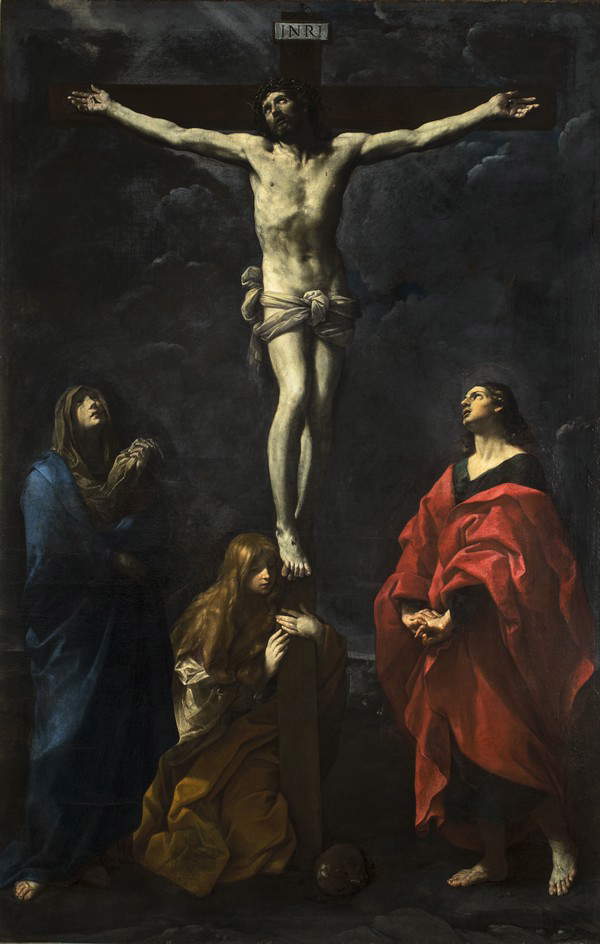 |
| Guido Reni, Jesus Christ Crucified, the Virgin of Sorrows, Saint Mary Magdalene and Saint John (1619; oil on canvas, 397 x 266 cm; Bologna, Pinacoteca Nazionale) |
 |
| Bartolomeo Cesi, Crucifixion (1595-1599; oil on canvas; Bologna, Church of San Girolamo della Certosa) |
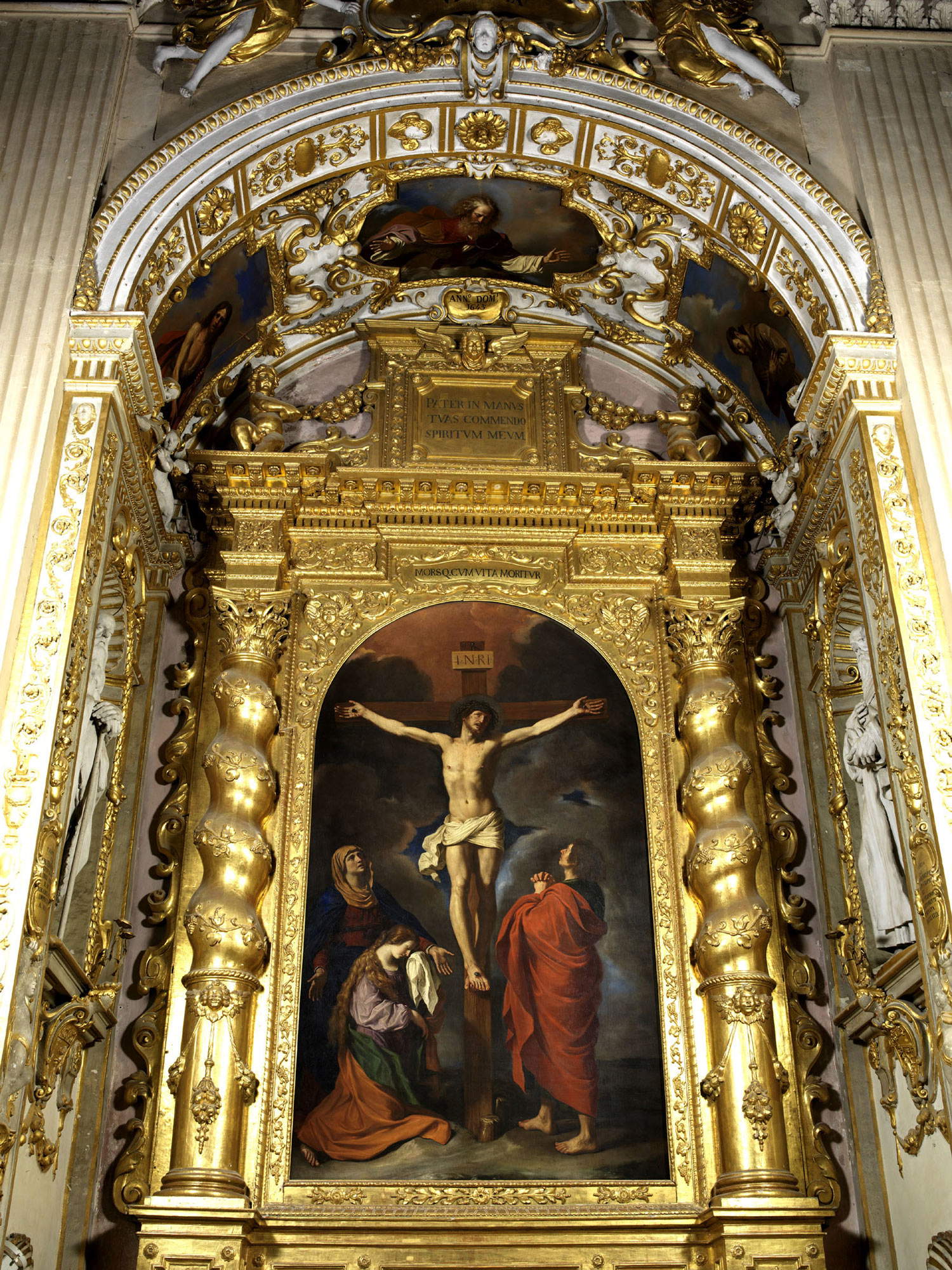 |
| The Barbieri Chapel in the Church of the Rosary in Cento |
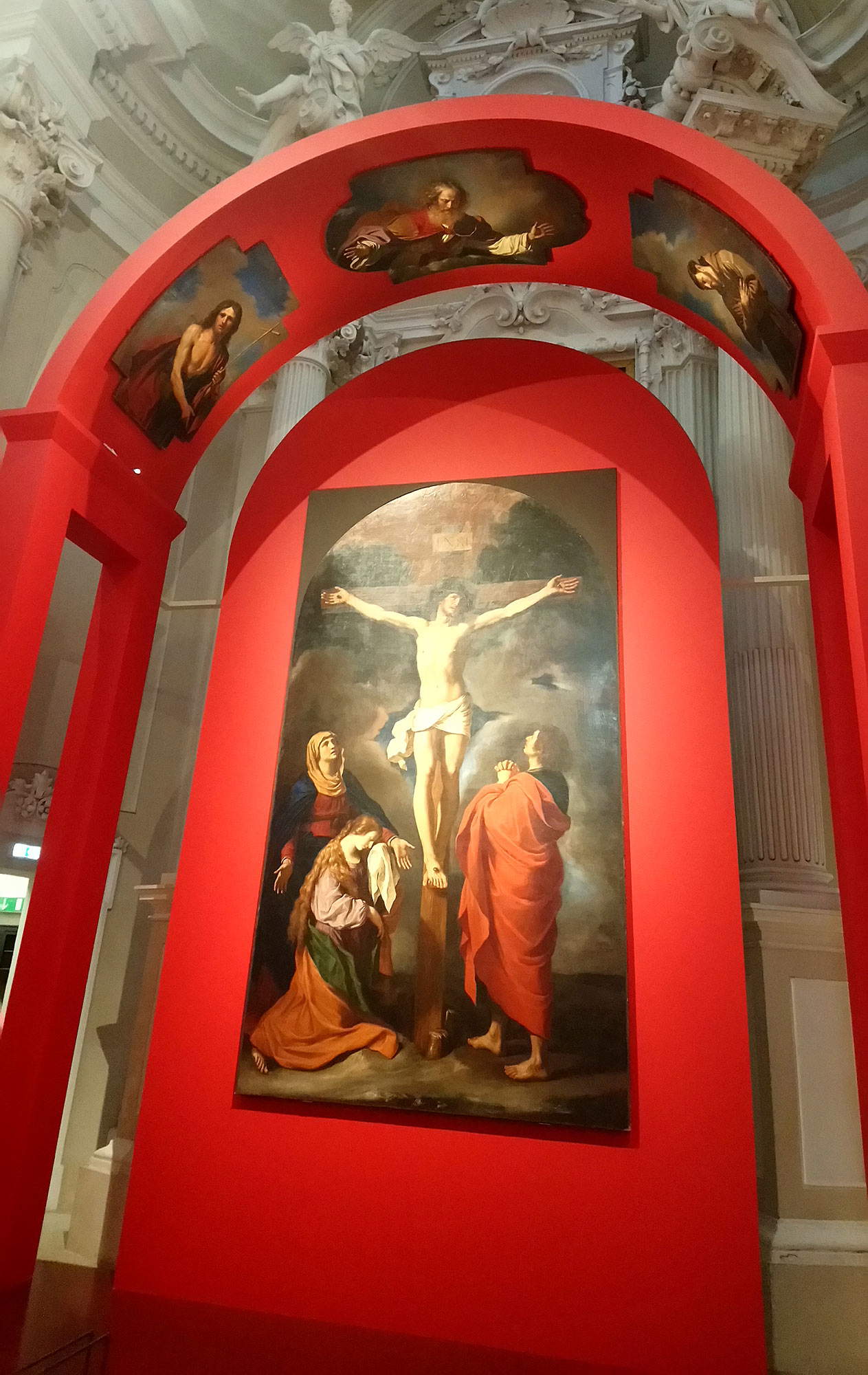 |
| The reconstruction of the Barbieri Chapel at the exhibition Emozione barocca. Guercino in Cento |
“Emotion” is the foundation of the exhibition that restores to Cento its Guercino, but it is also the key to reading much of his work, notably that produced in the mid-1940s, when, Sybille Ebert-Schifferer warned in her 1991 essay around the narrative structure of Guercino’s works, the art of the Cento artist most closely approximates the precepts of ancient rhetoric, which the painter approached by frequenting the cultured circles of Bologna at the time: a scholar of the time, Giovanni Battista Manzini, wrote that oratory and painting “are so closely joined, and cognate [....] between them, that there have been no lack of masters, who the very same rules of the one have prescribed et assignate for moderators of the other.” And among these masters was Guercino: after all, it is well known how the comparison between eloquence and painting was at the center of the artistic debate of the time. Just think of the theoretical work of Cardinal Paleotti, destined to direct art for decades, and with which the assumptions of Quintilian’sInstitutio (“dilettare, insegnare e movere”) were applied to art, or of Giovanni Paolo Lomazzo’s treatise on painting, which compiled a catalog of states of mind in order to find the most appropriate poses to render them with color and brush. Similar concerns moved theorists of music and literature as well, in an attempt to find the most appropriate ways to express human passions through art. “In all arts,” wrote Ebert-Schifferer, “the affective link with the public was established when pathos-filled forms of expression moved the viewer or listener either to empathy or to an Aristotelian catharsis [...]. [...]. It was according to these criteria that Manzini judged Guercino’s paintings” ("In all the arts the affective bond with the audience was established when pathos-filled forms of expression moved the viewer or listener either to empathy or to an Aristotelian catharsis [...]. It was according to these criteria that Manzini judged Guercino’s paintings.").
In the Barbieri chapel of the Rosario church, the involvement had to be total: a sacred drama, or a theater of the affections to use a felicitous expression of Andrea Emiliani, in which everyone is a participant, from the protagonists of the Crucifixion to the saints in the intrados who, looking down, mourn Jesus’ death on the cross, from the Eternal Father who comes to receive the soul of his son, to the faithful who enter the scenic space conceived by Guercino, becoming themselves part of a surprising and moving spectacle, far from the overwhelming fullness of the complex Baroque machines, but guided by that “moderation deriving from the limits consciously placed on the full and free expansion of life, guided rather by reason than by reason” of which Gnudi spoke in the introduction to the 1968 exhibition and which later Andrea Emiliani would summarize with the concept of “quiet osmosis between morality and aesthetics” moved by a “gentle inner order.”
Of that emotion, which Guercino wanted to bring to life in his chapel, echoes in the exhibition with which Cento intends to reciprocate the painter’s love, reciprocated, for the city. Never did the artist want to stray too far from his native town, the landscapes that are often admired in his paintings are none other than those that Guercino traveled as he ventured into the woods, along the rivers, among the rural areas outside the town, his paintings and frescoes did the churches and town houses proud, the life of seventeenth-century Cento echoes in many of his creations. And the community, in return, has elected it as a founding feature of the way it perceives itself, as its undisputed symbol, capable of bringing travelers from all over to this countryside, moved by the desire to observe up close and in person the world that can be read between the transparencies of its masterpieces. It is not known when the Church of the Rosary will reopen: it may take years to render the artist his temple. The exhibition hosted in the halls of San Lorenzo attempts, in part, to evoke the excitement of the Barbieri chapel, with an arrangement aimed at faithfully reconstructing the arrangement of the paintings in the apparatus that Guercino imagined. A semblance, one would think, a larva of what the real chapel was, a consolation, a palliative. But try to visit the exhibition in the company of a local inhabitant. One will soon realize that that theater lives on in the emotion with which the people of Cento enlighten themselves in recounting the works of their artist.
Warning: the translation into English of the original Italian article was created using automatic tools. We undertake to review all articles, but we do not guarantee the total absence of inaccuracies in the translation due to the program. You can find the original by clicking on the ITA button. If you find any mistake,please contact us.